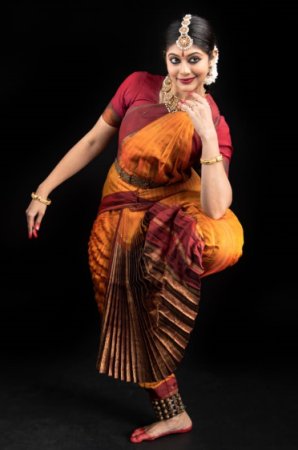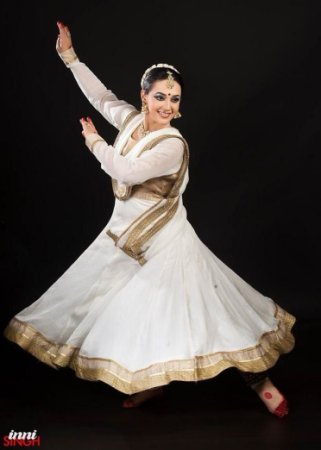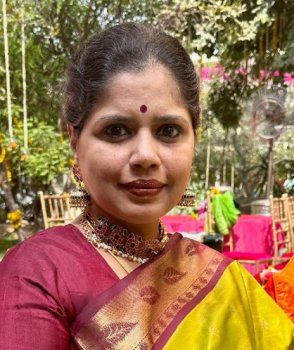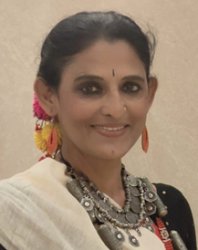
|   |

|   |
Journeys of depth and New Directions in Kathak and Bharatanatyam - Dr. Navina Jafa e-mail: navina.jafa@gmail.com October 29, 2023 The recently organised 8th edition of the Kalpodip Utsav by the enterprising Odissi dancer Pompi Paul at the India International Centre, Delhi, offered a glimpse of new approaches to some aspects of Indian classical dances. Critically examined is just one piece each from the performances of dancers Dakshina Vaidyanathan Baghel (Bharatanatyam) and Divya Goswami (Kathak). Both dancers, confident of their hold on the language of their respective dance forms, namely Bharatanatyam and Kathak, chose to present their story through the grammar of their dance form and each one invested in formal research of the subject they performed. Their presentation was thus not about the power play of technical histrionics of acrobatic dancing with the objective of 'wowing' the audience. The dancers intended to illustrate a dance process to tell a story and make the audience journey through that process. Dakshina Vaidyanathan's 'Ayoga Vaatsalya'  Dakshina Vaidyanathan Based on the theme of the journey of a pregnant mother anticipating her unborn child, Dakshina Vaidyanathan drew the idea for an expressional piece composed in ragam Jog, mishrachapu talam, from the concept of Ayoga Shringar. While the word 'Yoga' stems from the root Sanskrit word 'Yuj' - to join, and the prefix 'A'' denotes 'not joined', the concept of the emotion Shringar conveys the overarching idea of 'love'. Ayoga Shringar implies a seed with the potential for a journey of love bearing fruits of uniting or a sojourn where love remains ununited. The concept of Shringar (love in unison or in separation) is the emotion dominating the Indian arts (performing and visual). It is presented as the idea of beauty, love between two adults, Bhakti ¬- the devotion by a devotee towards his/her concept of 'God', and Vaatsalya - the love between mother and child. The 'Ayoga Vaatsalya' was a concept created by Dakshina to produce a dream of her life in pregnancy, where she imagined the life within her, and her eyes lit as she performed her vision of time playing and nurturing a young baby and toddler. The highlight of her piece was the bold presentation of a woman in labour bringing alive the small sculptural frieze in the 10th-century Modhera Sun Temple in Gujarat. The building of the labour pain, the appearance of a young life from the womb, and most of all, the poignant moment when the umbilical cord that bonded the energy within the woman's body is cut for the baby to begin its own individual journey in the world - Dakshina's rendering was powerful, dynamic and immersed. Yet, as Dakshina said, "The bonding remains like the blooming lotus with the rays of the sun, the river with the ocean, the peacock with the dark clouds and rain; the examples are endless." A tribute to her grandmother, Bharatanatyam dancer Late Saroja Vaidyanathan, the Ayoga Vaatsalya reaffirmed the idea of parampara,¬ the flowing tradition from one generation to another. Divya Goswami's 'Nadant'  Divya Goswami Divya Goswami chose to perform the concept of 'Shiva' by selecting just one motif - the serpent. The original composition was a Dhrupad in raag Desh composed by iconic singer Pandit Jasraj, but Divya adapted the composition for her Kathak dance, anchoring it in the frame of the dense 12-beat rhythmic cycle Chautaal. The words, Gale bhujang bhasma ang Shankar anuraagi define friends of Shiva - the serpent wraps itself around his throat, and ashes decorate his body. The dancer went beyond the words to recreate the snake moving in outer space and reflecting the movement of the journey within where the energy functioned to cleanse and evolve the super consciousness. The Kathak language brought out what Stella Kramrisch, the pioneering art historian and curator, offered in exploring the transcendental idea of Shiva interpreting sculptural depictions ranging from Ellora to Badami, from Elephanta to Kandariya Mahadev, the Wild God, the Great Yogi, the guardian of the ultimate truth. The two-dimensional flowing movements of Kathak, along with the rhythmic patterns and aligned with punctuated use of pirouettes (chakkars), represented the movement of the serpent such that the language of the dance told the commanding natya-nritya story of the symbol and went beyond the usual display of Kathak technical theatrics. The highlight of Divya's performance was the rising serpentine kundalini energy powerfully displayed using clearly defined footwork and accompanying facial and hand movements. It was a relief to witness that a younger generation Kathak dancer, Divya Goswami is thinking beyond the power play of spins and padding of packaged lighting and designer costuming, and bringing in intellectual discourses in the frame of Kathak performance. The Singer - The transformed accompanist  Sudha Raghuraman Sudha Raghuraman trained in both Carnatic and Hindustani music, sang for both dancers and also composed for Dakshina, drew extraordinary admiration from her and Divya who described the sensitivity and the deep involvement of the singer in transforming the music for dance. The singing was not dominating the dance but blending with the performance, providing the dancers the space to live the journey of the story-making on stage. In totality the music and rhythmic accompaniment was extraordinary. Divya's music production included tabla by Amaan Ali, Mudassir Khan on the sarangi, Manohar on mridangam and flute by Kiran Kumar, recitation and creative guidance by Dr Sridhar Vasudevan. Dakshina's musicians comprised of mridangam by Manohar Balatchandirane, flute by G Raghuraman and nattuvangam by K Sivakumar. Patrons and Socio-Economics Patrons and patronage forming the socio-economic frame drive the aesthetics of creative production. Odissi dancer Pompi Paul, based out of Jalpaiguri, who also presented a graceful performance with her group, was able to offer the Kalpodip festival with two other organisations, Surchandam and Niv Art Centre. The selection of the artistes Dakshina Vaidyanathan and Divya Goswami illustrated their vision of showcasing the Indian classical dancer who has the potential to make a difference to their respective dance traditions in the present, where funding and patronage moving fast from the state-dominated patronage into the private domain is taking centre stage.  Dr Navina Jafa is a well-known Kathak dancer and dance and art historian who also works in the space of culture and sustainable development. |